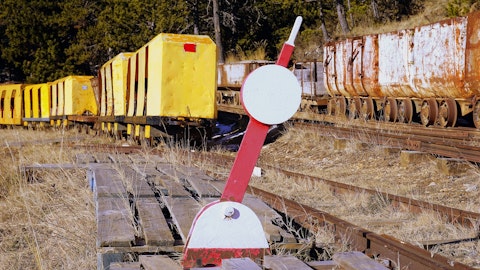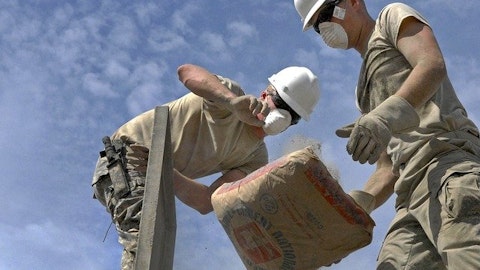Operator: Thank you. Your next question is coming from Andreas Bokkenheuser from UBS. Andreas your line is live.
Andreas Bokkenheuser: Thank you very much. Just one question for me. Just switching gears a little bit over to the long steel segment, what are you seeing there in terms of potential new orders coming in from the infrastructure bill, the IRA. Are you seeing anything yet there? We have obviously seen rebar is kind of coming down for the last six, seven months. It doesn’t feel like the infrastructure build is kind of abating yet. But what are you seeing on your side to kind of stop the rebar price decline?
Mark Millett: Well, as we have suggested in the past, we are not big in the rebar markets in at. But nonetheless, from our structural long products perspective, the infrastructure bill or spending is not necessarily kicked in yet. It typically takes six to nine months for that to materialize. And obviously, it is too soon. But come the summer of this year, I think you will start to see some benefit there.
Andreas Bokkenheuser: Got it, that is very clear. Thank you Mark.
Operator: Thank you. Your next question is coming from Lawson Winder of BofA Securities. Lawson your line is live.
Lawson Winder: Hi good morning Mark, good morning Theresa, thank you for today’s call. Maybe could I ask about the dividend outlook and just kind of get your thoughts on return of capital. So last year, you bumped the dividend quite substantially. And this year, you have expressed some confidence in symptom and Sinton wasn’t contributing, in fact, was a drag in 2022 so maybe just kind of your thoughts around 2023. Thank you.
Theresa Wagler: Good one. I’m smiling because Mark tosses things my way, and it is funny how he does it. But from a dividend perspective, we do like to grow the dividend in a way that is consistent so that we are constantly having increases across the spectrum. And I think as I mentioned, since 2017, we actually increased the dividend by almost 120%. And we like to do that lockstep with free cash flow increases that are through cycle like Sinton. I would expect that we should have a pretty significant increase coming forward as well. We like to do those traditionally in the first quarter time frame. We have additional projects that are a little bit smaller, but that are coming online in 2023 that will add to through-cycle earnings. And given our stock price, which has been fantastic, driving up recently, you should expect to see strong shareholder distributions continue, and that would include a strong increase in the dividend coming forward.
Lawson Winder: Okay, fantastic. Thank you. Congratulations.
Operator: Thank you very much. Our next question is coming from John Tumazos, of John Tumazos Very Independent Research. John your line is live.
John Tumazos: Thank you. I try to keep a little spread on non-scrap cost of goods sold per ton just taking your total corporate revenues per ton and pretax per ton and subtracting scrap profits and it peaked a year ago at 673 and was only 4.56% this quarter. Are the bigger contributors to that the much lower price of purchased steel for your galvanizing and painting, et cetera, divisions first, lower profit sharing improvement in the Sinton mill as it ramps up, and hopefully, it will be the lowest cost when it is four and maybe a mix shift into some. So please explain – by the way, Nucor’s non-scrap cost of goods sales went up and were the highest in the last two-years in the current quarter. So there is the opposite direction, but that is a separate problem to figure out.
Mark Millett: John, great to have you on the call as always, and thanks for the question. I think the biggest parameter is substrate costs. As we have – over the years, we have ramped up the tech substrate, Holland substrate and even at Sinton, we actually pre-purchased about 150,000 tons, maybe a little more to load the downstream coating lines in preparation for when the hot mill started up. So you are certainly seeing that influence our costs, for sure.
Theresa Wagler: And the other thing that you hit, John, was spot on as well. It has to do with mix. So if you think about the increase in the impact from our fabrication business, that we would have had some change in that as well. So I think it is both mix and what Mark talked about is the steel substrate.
John Tumazos: In your steel mills, with the normal non-scrap cost of goods sold be closer to $200 a ton or $250 tons or $300 tons.
Mark Millett: We have always tried to not share that information, John. So I would prefer to stay that way. I would tell you though that, one, our conversion cost is probably as good as anyone in the world. And number two, the people don’t necessarily recognize the offsetting sort of efficiency or effectiveness of volume. So on our process lines, carbonizing lines prepaint lines, even though some of the input costs have appreciated, the fact that our teams continually just improve productivity, put more volume through offsetting the sort of the overhead and the fixed costs. Our actual processing costs on those lines have been sort of almost stagnant for the last, I don’t know, how many years.
John Tumazos: Thank you very much.





